Vangi Bath is a healthy and tasty brinjal rice dish popularly made in the Maharashtrian and Karnataka cuisine.
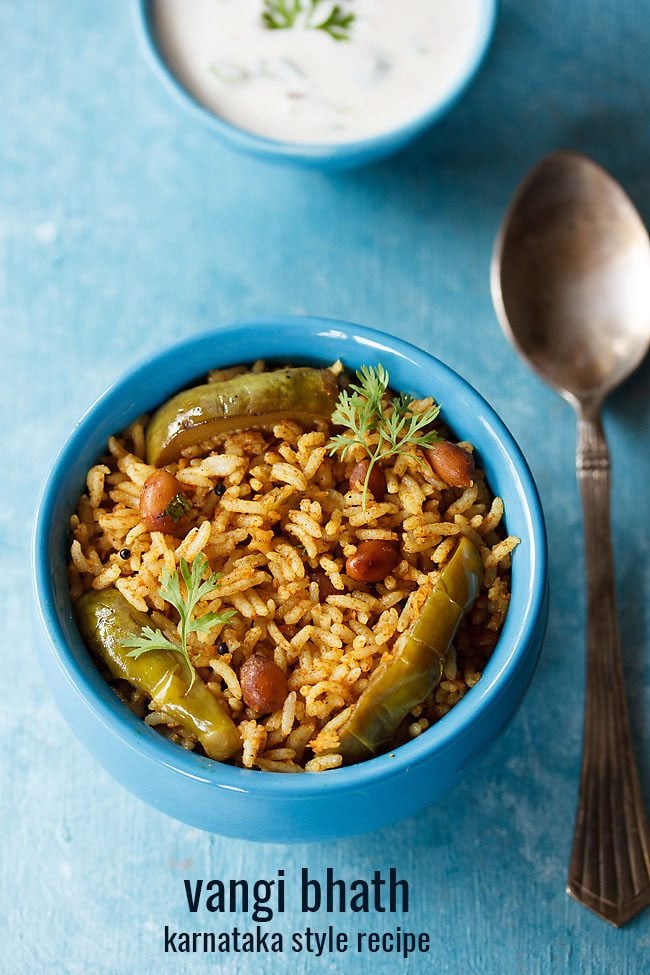
Both the regional recipes taste different as some of the ingredients and the spices that go into preparing them are different.
In this post, I am sharing both regional variations of making this recipe.
- Vangi Bath Karnataka Style – Made with Vangi bath masala powder and tamarind pulp.
- Vangi Bhath Maharashtrian Style – Made with Goda Masala and curd or tomatoes.
Both the recipes are healthy and taste good. You can make either of them as per your preference.
Table of Contents
About Vangi Bath Karnataka Style
This is a delicious, healthy and vegan recipe of spiced brinjal rice from the Karnataka cuisine. Vangi means, brinjal, baingan, aubergines or eggplant. Bhath or bath or baath means rice.
Preparing vangi bath is very easy. All you need is to cook the rice first. Then prepare the brinjal gravy. Then mix the rice with the brinjal gravy. If you have extra cooked rice or leftover rice, then the vangi bath is quicker to prepare.
In this recipe, I have used readymade organic vangi bath masala powder from the Phalada brand. The taste of the vangi bath depends on the quality of the vangi bath masala. So do use a good quality one. You can use homemade or store brought.
Generally, green brinjals are used. But you can also use purple or purple striped brinjals. Just make sure that the brinjals are tender and fresh.
You can use any regular variety of rice like sona masuri. This is a no onion no garlic recipe. If you want, you can add onions.
Serve vangi bath with raita or plain curd. You can even pack it in the tiffin box.
How to make Vangi Bath (Karnataka Style)
1. First, soak 1 heaped cup rice in water for 30 minutes. Use any regular rice. I used sona masuri rice.

2. Then pressure cook the rice with 2 cups water, ¼ teaspoon salt for 3 to 4 whistles on medium flame or for 11 to 12 minutes. You can also cook the rice in a pot. If cooking in a pot, then you may need to add more water. Depending on the quality of rice, you can even cook for 2 whistles or 9 to 10 minutes.
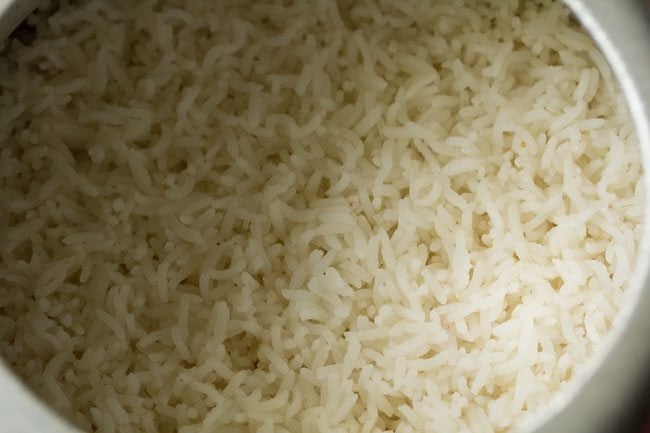
3. Soak ½ tablespoon tightly packed tamarind in ¼ cup hot water for 20 to 30 minutes.
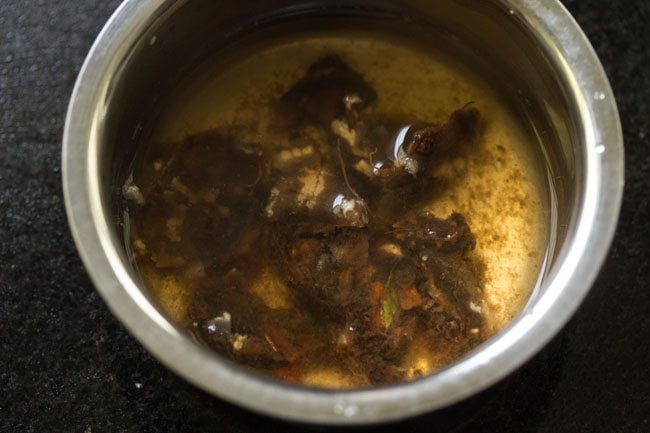
4. Later squeeze the soaked tamarind in the water to get the tamarind pulp. Strain and keep aside

5. when the pressure settles down on its own, open the cooker’s lid and fluff the rice. You can allow the rice to cool in the cooker itself or spread rice on a large plate/thali or tray.
Allow the cooked rice grains to become warm or cool down. Cover and keep so that the rice grains do not dry out. The cooked rice grains should be separate.

6. when the rice is cooking, rinse, remove the crowns of the brinjals (vangi or baingan) and slice them vertically in 4 pieces.
As soon as you chop them, place them in a bowl containing water to which some salt has been added.
Do make sure that there is sufficient water covering the brinjals. Allow them to be in the salted water for 15 to 20 minutes.

Making vangi bath
7. Heat 2 tablespoons peanut oil (can also use sesame oil or sunflower oil) in a pan or kadai. Add ½ teaspoon mustard seeds.

8. Once the mustard seeds begin to crackle, then add ½ teaspoon urad dal.
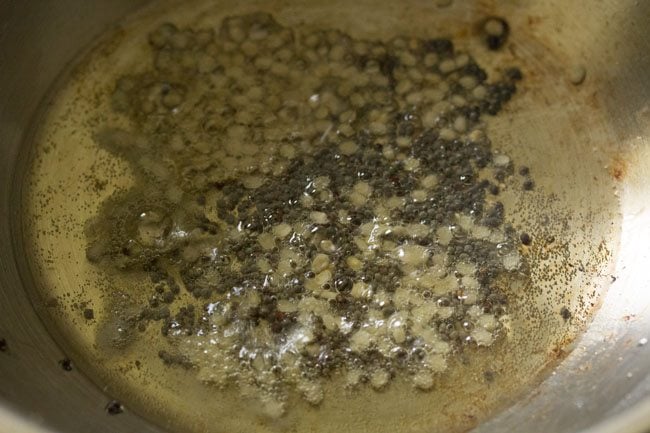
9. Next add 2 tablespoons roasted peanuts or cashews.

10. Sauté till the urad dal becomes golden.
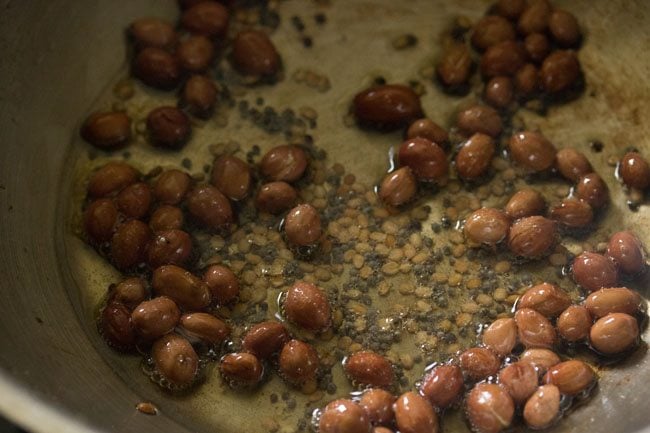
11. Then add 1 to 2 dry red chilies, 1 sprig curry leaves or 10 to 12 curry leaves and 1/8 teaspoon asafoetida (about 2 pinches of asafoetida).
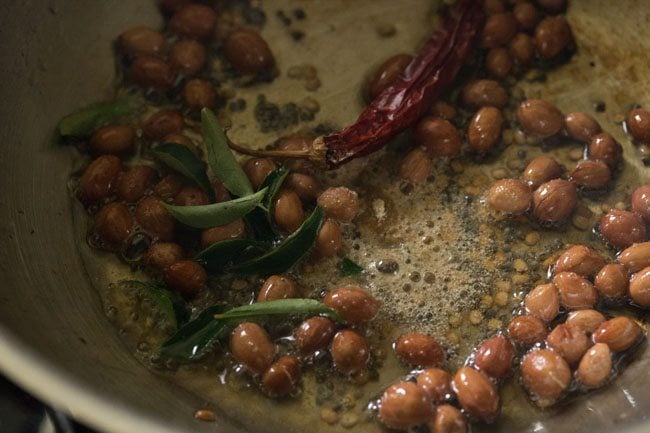
12. Add the brinjals. Just remove the brinjals from the salted water and add in the pan. Be careful as the mixture splutters when adding brinjals.
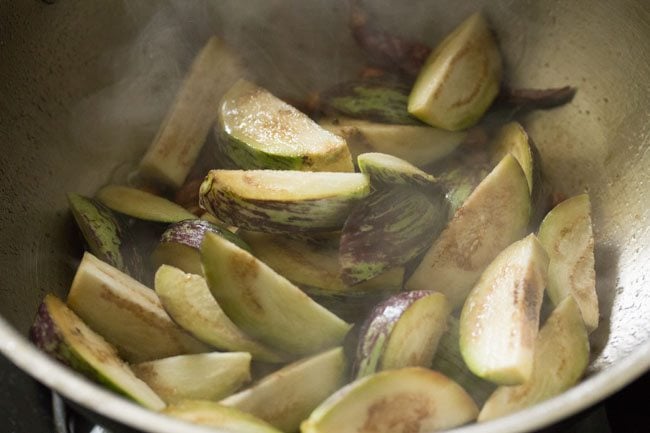
13. Mix them with the rest of the tempering mixture.
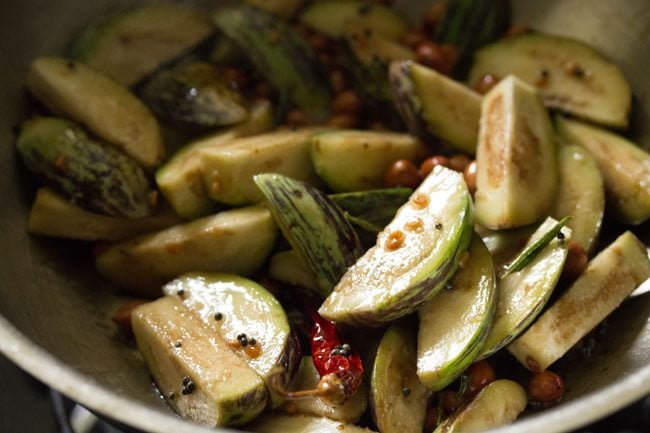
14. Add ¼ teaspoon turmeric powder. Also add salt as per taste.

15. Mix the turmeric powder and salt very well.
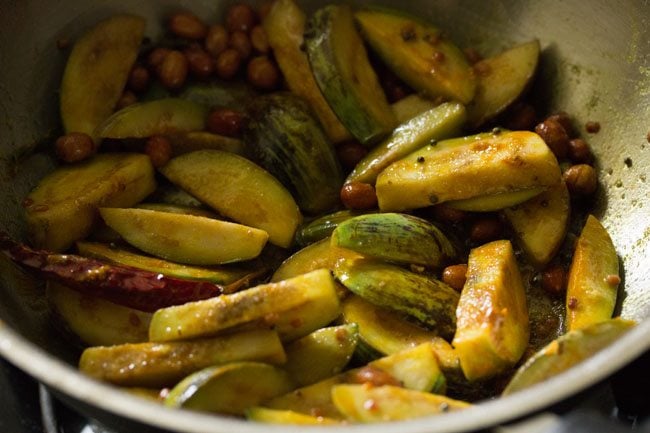
16. Cover the pan with a lid and let the brinjals get half-cooked. Do check at intervals. while cooking, if the brinjals start sticking to the pan then add some water. Then cover and cook.

17. Half cook the brinjals.
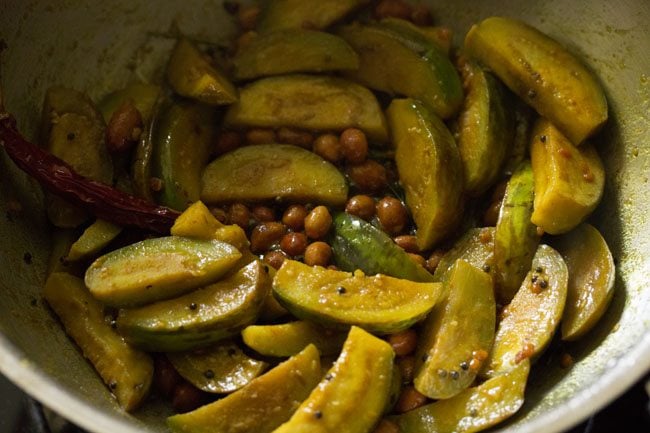
18. Once they are half done, then add the tamarind pulp.

19. Then add 2 to 2.5 tablespoons vangi bath masala powder.
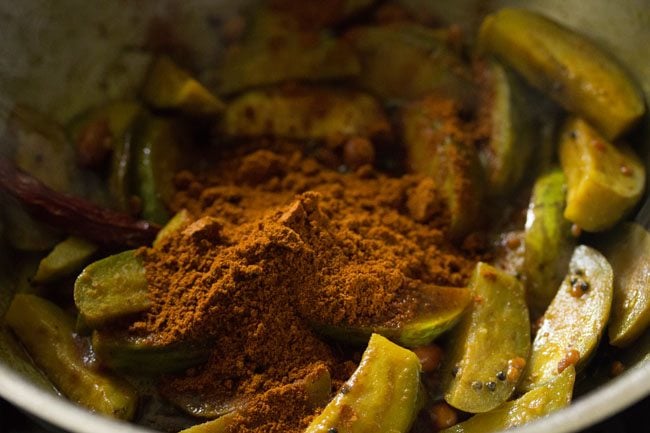
20. Mix very well and continue to cook without the lid. If the masala along with brinjals starts sticking to the pan, then add ¼ cup water and continue to cook.
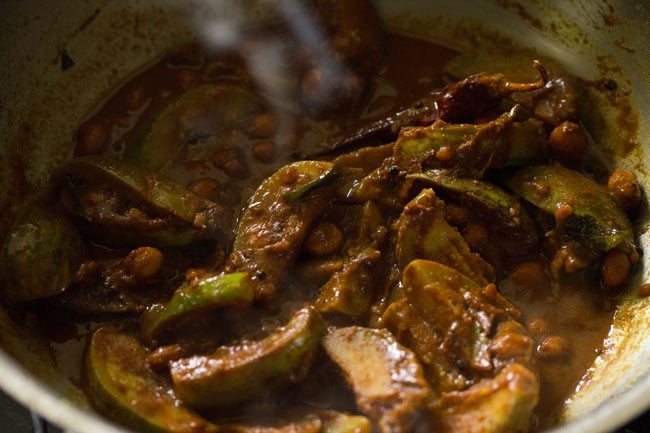
21. Once the brinjals are cooked well, add 2 tablespoons grated coconut and ¼ to ½ teaspoon jaggery powder.
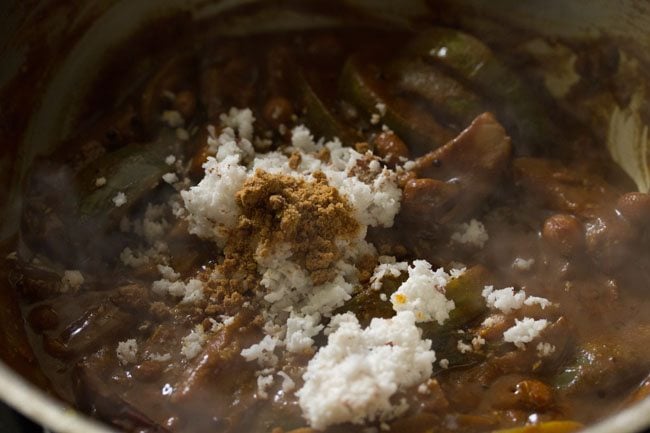
22. Mix again very well. The brinjal masala is thick. But for some moisture you can have a semi gravy consistency in the brinjal masala.
Check the taste and you can add some more jaggery powder or salt if you want.
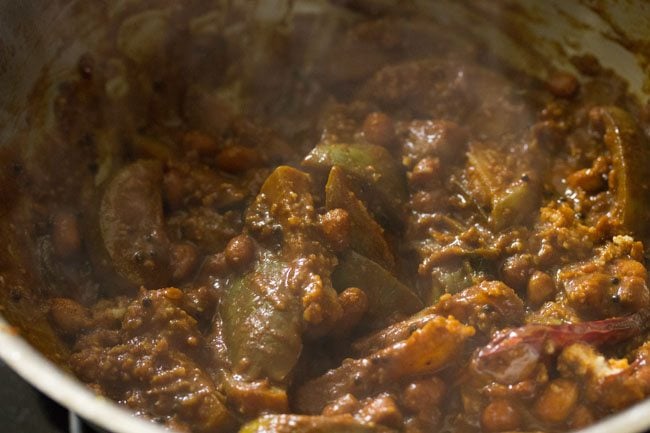
23. Keep the pan down and add rice in two to three parts. Mix gently.

24. Add the next portion of rice and then mix well.
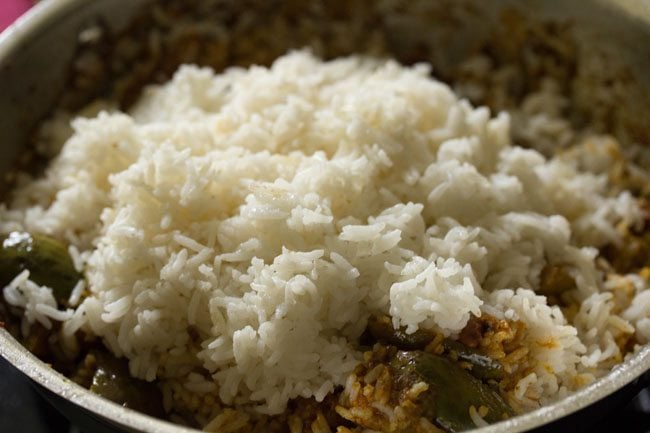
25. Mix gently but very well so that everything is mixed evenly.
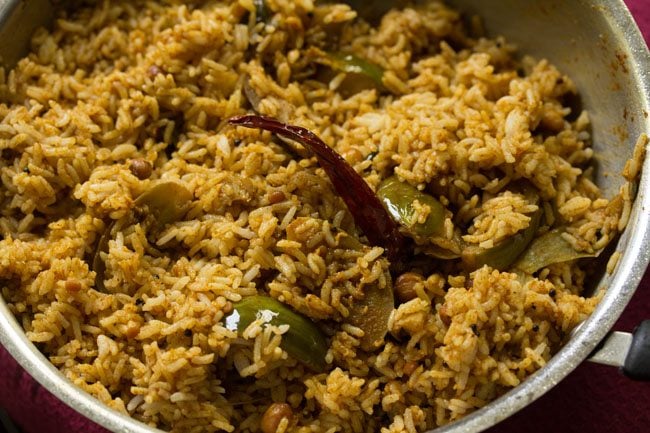
26. Serve vangi bath with raita, papads or chips.

About Maharashtrian Vangi Bath
This is a tasty, nutritious and popular Maharashtrian one-pot meal dish of spiced rice dish made with brinjal and freshly ground spices.
This brinjal rice recipe is prepared in the same way as a Masale bhaat or Tondli bhaat (Ivy gourd rice). Goda Masala is added in these rice recipes and this spice blend gives the Maharashtrian vangi bath its unique flavor, taste and aroma.
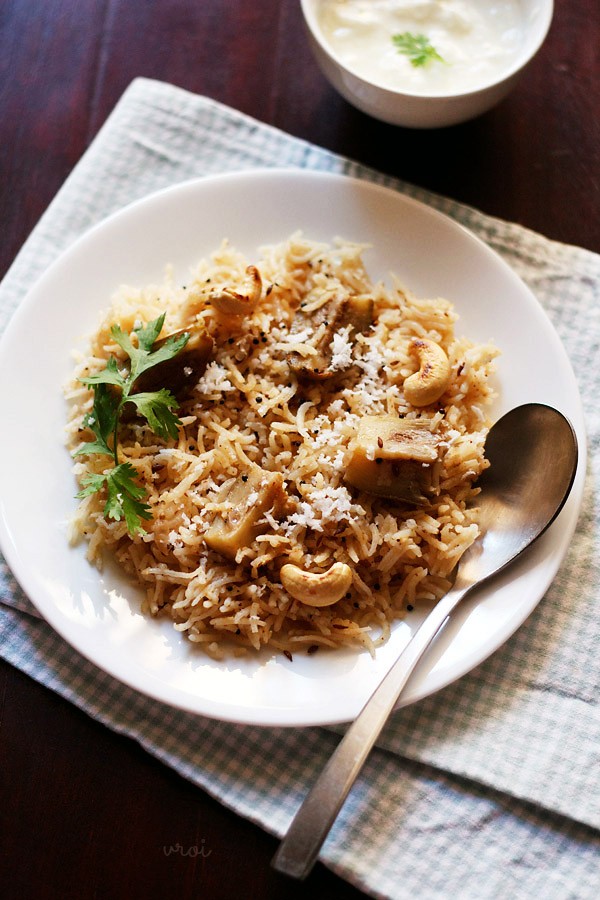
In this brinjal rice recipe, I have roasted and ground the spices to prepare the goda masala, so there is no need of having a ready goda masala. If you do have goda masala powder, then skip grounding the spices.
It is a relatively easy recipe to prepare. One-pot meal which is healthy as well does not take much time if you have ready goda masala. I have cooked the rice in a kadai, but you can also cook in a pressure cooker.
I have added onions in this recipe. You can easily skip them if you don’t have onions and add a pinch of asafoetida (hing) in the tempering instead.
Serve vangi bath plain or with a side bowl of yogurt or raita.
How to make Maharashtrian Vangi Bath
1. On a low flame in a small frying pan, dry roast the whole spices till they are aromatic.
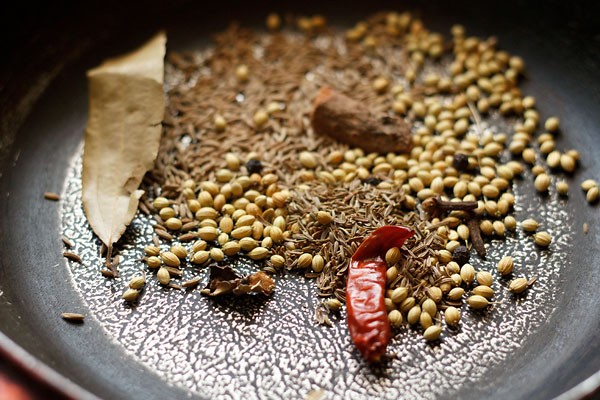
2. Bring the roasted spices to the side of the pan and add the desiccated coconut and sesame seeds.

3. Stir & continue to dry roast till the coconut becomes golden. Keep stirring regularly so that the coconut does not get burnt. Let this spice and coconut mixture cool.
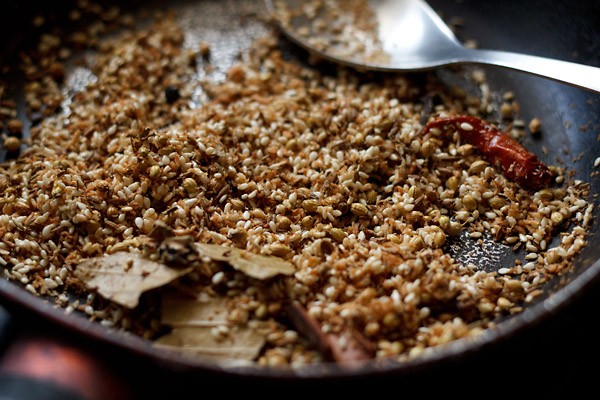
3. Soak the rice in water for 30 minutes and then drain them. Keep aside. You can add basmati rice or ambe mohur rice (mango blossom rice) and even sona masuri.
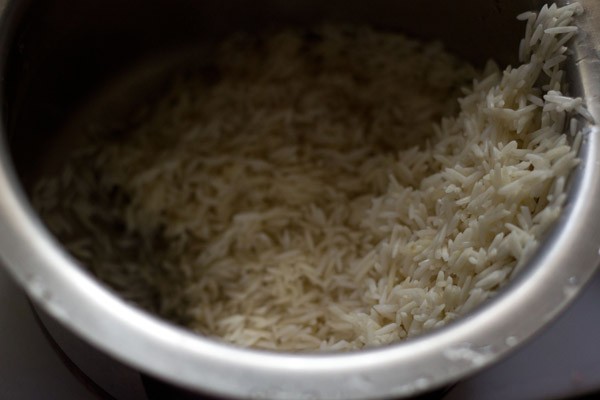
4. Quarter or chop the brinjals (vangi). Keep the chopped brinjals in a bowl of salted water for 15 minutes. This does not discolor them and gets rid of the bitterness if any.
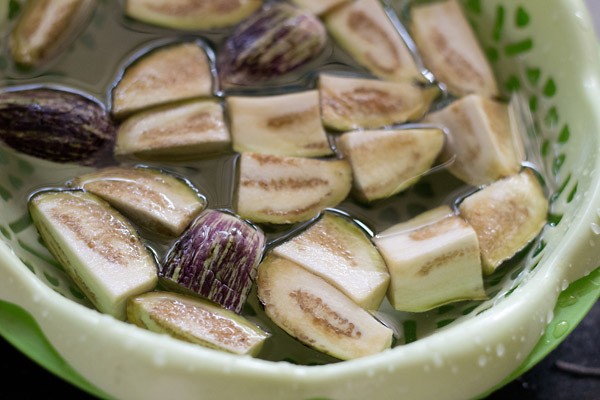
5. Once the roasted spices + coconut mixture gets cooled, grind them fine in a dry grinder or coffee grinder.
Only 2 to 3 tsp of the goda masala (as per your taste) needs to be added to the rice.
The remaining goda masala can be refrigerated and added to vegetable dishes or lentils.

6. Heat oil in a large thick bottomed pan. First, splutter the mustard seeds and cumin seeds.

7. Then add onions and saute till the onions turn translucent.
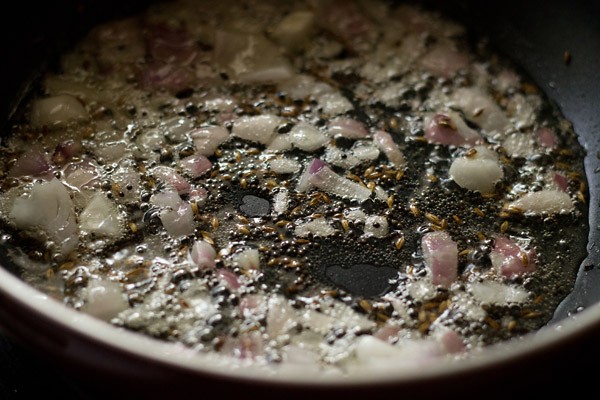
8. Add curry leaves and green chilies. Stir.
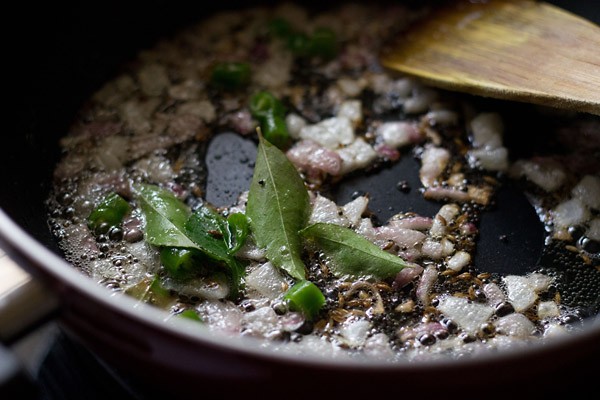
9. Then add the drained brinjals (vangi) along with turmeric powder. Stir and saute for 3 to 4 minutes.

10. Stir and then add the soaked rice, 2 to 3 tsp of the freshly ground goda masala and yogurt.

11. Stir and pour water. Season with salt.

12. Stir very well.
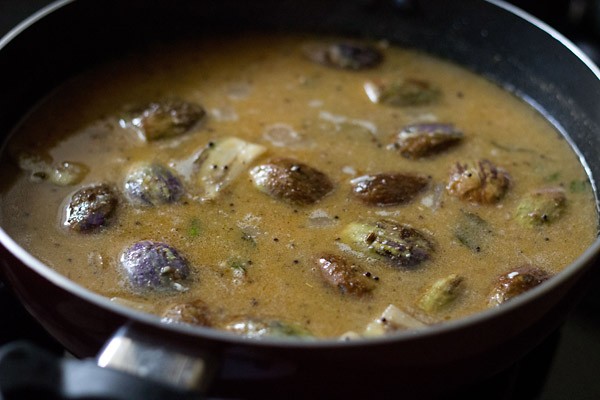
13. Cover with a lid and cook the rice on a low flame till the grains are tender and cooked.
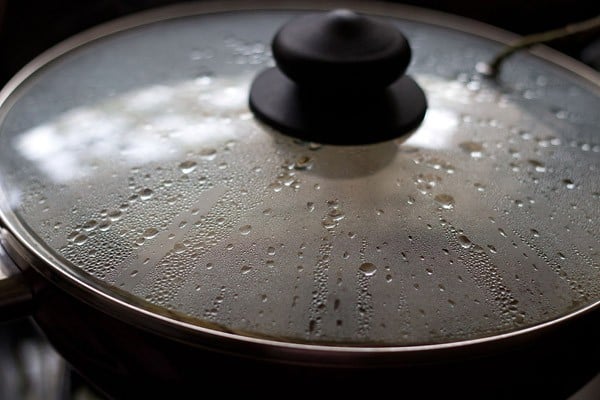
14. Meanwhile, roast cashews in a pan till they get some brown spots on them. You can also add peanuts instead of cashews. Just roast them in the same way.
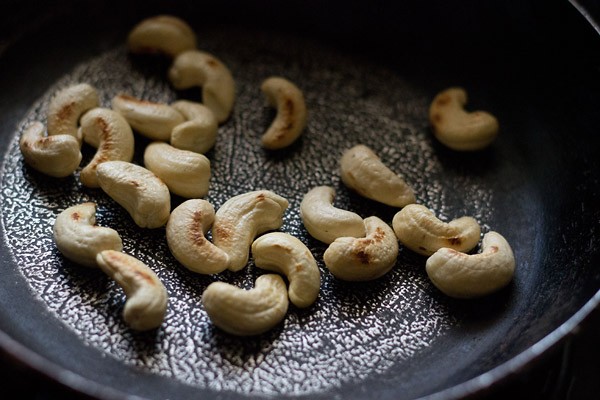
15. Once the rice is cooked, fluff gently.

16. Add grated coconut, chopped coriander leaves and the roasted cashews. Mix gently.
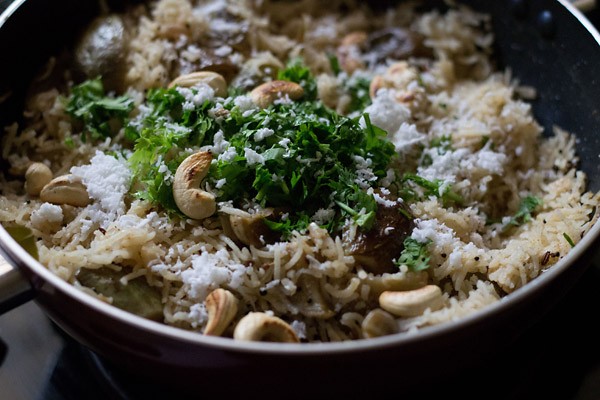
17. Serve vangi bhat plain or with curd or with raita hot or warm. You can also top with a bit of ghee while serving.

More popular rice recipes
Please be sure to rate the recipe in the recipe card or leave a comment below if you have made it. For more vegetarian inspirations, Sign Up for my emails or follow me on Instagram, Youtube, Facebook, Pinterest or Twitter.

Vangi Bath (Brinjal Rice)
Ingredients
for cooking rice
- 225 grams sona masuri rice or 1 heaped cup of rice
- ¼ teaspoon salt
- 2 cups water
for preparing tamarind pulp
- ½ tablespoon tightly packed tamarind
- ¼ cup hot water
other ingredients
- 2 tablespoons peanut oil – can also use sesame oil or sunflower oil
- ½ teaspoon mustard seeds
- ½ teaspoon urad dal
- 2 tablespoons roasted peanuts or cashews
- 1 sprig curry leaves or 10 to 12 curry leaves
- ⅛ teaspoon asafoetida (hing)
- 1 to 2 dry red chilies
- 200 grams small to medium sized green or purple brinjal (baingan or vangi or egg plant) – cut in long pieces and soaked in salted water for 15 to 20 minutes
- ¼ teaspoon turmeric powder
- 2 to 2.5 tablespoons vangi bath masala powder
- salt as per taste
- 2 tablespoon fresh grated coconut, optional
- ¼ to ½ teaspoon jaggery powder
- 2 to 3 tablespoons chopped coriander leaves – optional
Instructions
preparation
- First soak 1 heaped cup rice in water for 30 minutes. Use any regular rice. I used sona masuri rice.
- Then pressure cook the rice with 2 cups water, ¼ teaspoon salt for 3 to 4 whistles on a medium flame or for 11 to 12 minutes. You can also cook the rice in a pot. If cooking in a pot, then you may need to add more water.
- Soak ½ tablespoon tightly packed tamarind in ¼ cup hot water for 20 to 30 minutes.
- Later squeeze the soaked tamarind in the water to get the tamarind pulp. Strain and keep aside.
- When the pressure settles down on its own, open the cooker’s lid and fluff the rice.
- You can allow the rice to cool in the cooker itself or spread rice on a large plate/thali or tray. Allow the cooked rice grains to become warm or cool down. Cover and keep so that the rice grains do not dry out.
- When the rice is cooking, rinse the brinjals. Remove the crowns of the brinjals and slice them vertically in 4 long pieces. As soon as you chop them, place them in a bowl containing water to which some salt has been added.
- Do make sure that there is sufficient water covering the brinjals. Allow them to be in the salted water for 15 to 20 minutes.
making vangi bath
- Heat 2 tablespoons peanut oil (can also use sesame oil or sunflower oil) in a pan or kadai.
- Add ½ teaspoon mustard seeds.
- Once the mustard seeds begin to crackle, then add ½ teaspoon urad dal.
- Next add 2 tablespoons roasted peanuts or cashews.
- Saute till the urad dal becomes golden.
- Then add 1 to 2 dry red chilies, 1 sprig curry leaves or 10 to 12 curry leaves and ⅛ teaspoon asafoetida (about 2 pinches of asafoetida).
- Add the brinjals. Just remove the brinjals from the salted water and add in the pan. Be careful as the mixture splutters when adding brinjals.
- Mix them with the rest of the tempering mixture.
- Add ¼ teaspoon turmeric powder. Also add salt as per taste.
- Mix the turmeric powder and salt very well.
- Cover the pan with a lid and let the brinjals get half-cooked. Do check at intervals. While cooking, if the brinjals start sticking to the pan then add some water. Then cover and cook.
- Half cook the brinjals.
- Once they are half done, then add the tamarind pulp.
- Then add 2 to 2.5 tablespoons vangi bath masala powder.
- Mix very well and continue to cook without the lid. If the masala along with brinjals start sticking to pan, then add ¼ cup water and continue to cook.
- Once the brinjals are cooked well, add 2 tablespoons grated coconut and ¼ to ½ teaspoon jaggery powder.
- Mix again very well. The brinjal masala is thick. But for some moisture you can have a semi gravy consistency in the brinjal masala.
- Keep the pan down and add rice in two to three parts. Mix gently.
- Add the next portion of rice and then mix well.
- Mix gently but very well so that everything is mixed evenly.
- Serve vangi bath with raita, papads or chips.
Nutrition Info (Approximate Values)
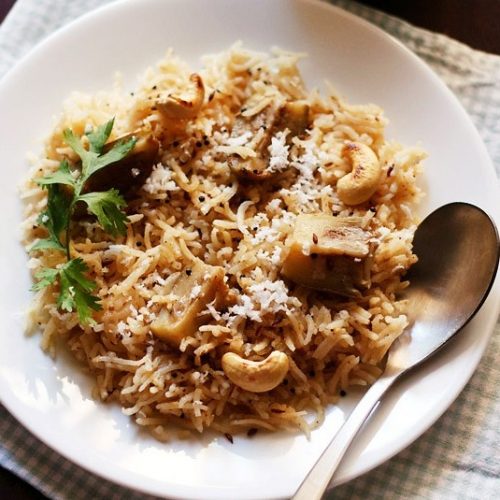
Vangi Bath
Ingredients
for the goda masala
- 1 small tejpatta (indian bay leaf)
- 1 small piece of dagad phool (stone flower or patthar phool)
- 2 teaspoon coriander seeds
- 1 dry red chili, kashmiri or byadagi or bedgi chili
- 1.5 tablespoon unsweetened desiccated coconut
- 1 teaspoon cumin seeds
- 3 cloves
- 1 inch cinnamon
- ½ teaspoon caraway seeds
- 1.5 tablespoon white sesame seeds
- 4 black peppercorns
- 1 pinch asafoetida (hing)
remaining ingredients
- 1.5 cups basmati rice or ambe mohur rice
- 4 to 5 medium brinjals (vangi or baingan or eggplant) or 8 to 10 small brinjals or about 200 grams
- 1 green chili, chopped
- 1 medium onion, finely chopped
- 2 tablespoon Curd (yogurt) or 1 medium tomato, chopped
- 6 to 7 curry leaves or 1 tejpatta (indian bay leaf)
- 15 to 18 cashews or peanuts
- ¾ teaspoon mustard seeds
- ¾ teaspoon cumin seeds
- ¼ teaspoon turmeric powder
- ½ tablespoon chopped coriander leaves
- 1 tablespoon grated coconut
- 3 cups water for cooking the rice, add more if required
- 2 tablespoon peanut oil or any vegetable oil
- salt as required
Instructions
making goda masala
- On a low flame in a small frying pan, dry roast the whole spices mentioned under the list “for the goda masala”, except sesame seeds and desiccate coconut. Roast the spices till they become aromatic.
- Then add the desiccated coconut and sesame seeds and continue to dry roast till the coconut becomes golden. Keep stirring regularly so that the coconut does not get burnt. Let this spices cool.
- Once the roasted spices + coconut mixture gets cooled, grind them fine in a dry grinder or coffee grinder.
- Keep this small batch of goda masala aside and just add about 2 to 3 tsp of it in this recipe. The remaining goda masala can be kept in the fridge in a small bowl or box and added to veggie dishes or dal.
soaking rice and brinjals
- Rinse the rice for a few times in water. Then soak the rice in water for 30 minutes and then drain them. Keep the soaked rice aside.
- Quarter or chop the brinjals (vangi)
- Keep the chopped brinjals in a bowl of salted water for 15 minutes. This soaking does not discolor them and gets rid of the bitterness if any.
making maharashtrian style vangi bath
- Heat oil in a large thick bottomed pan and splutter the mustard seeds and cumin seeds.
- Then add onions and saute till the onions turn translucent.
- Add curry leaves and green chilies. Stir.
- Then add the drained brinjals (vangi) along with turmeric powder.
- Stir and saute 3 to 4 minutes.
- Then add the soaked rice, 2 to 3 tsp of the freshly ground goda masala and yogurt.
- Stir and pour water. Season with salt. Again stir very well.
- Cover with a lid and cook the rice on a low flame till the grains are tender and cooked.
- In case the rice has not cooked and the water has dried, add some water and stir gently and continue to cook the rice.
- Meanwhile, roast cashews in a pan till they get some brown spots on them. Instead of cashews, you can also add peanuts and roast them in the same way.
- Once the rice is cooked, fluff gently.
- Add grated coconut, chopped coriander leaves and the roasted cashews. Mix gently.
- Serve vangi bath plain or with raita hot or warm.
- You can also garnish it with coriander leaves and grated coconut while serving.
Notes
- For cooking in a pressure cooker – add about 2.5 to 2.75 cups water and pressure cook for 2 to 3 whistles.
This Vangi Bath recipe post from the archives first published in November 2016 has been republished and updated on 5 June 2020.









I just wanted to check if I am making it right and OLA !!! You gave the exact same recipe … I love vaangi bhaat, am going to make it right now .. thanks for being so precise .. keep it up ????????????????
thanks a lot brinda. happy cooking and i hope you like the recipe.
Well narrated recipe Dasannaavre. Dhanyabaadagalu. Will try today.
thanks arathi. do try the vangi bath and i hope you will like it.
Looks delicious.. When roasting peanuts, the flame is high or med-low? I assume they will absorb oil and get soggy if roasted at low flame
ruchi, the flame is medium-low or medium if using a thick bottomed pan. the peanuts do not absorb oil. if the oil is cold, then the peanuts absorb oil. here we are adding peanuts once the mustard seeds crackle. mustard seeds crackle in hot oil, so in this hot temp, the peanuts get roasted well. i had used a steel pan and its gets very hot even on low flame, so i have kept the flame to a low.
Thank you very clarifying. I’ll use this technique while making poha also then.
Is vangi bath masala same as goda masala?
welcome ruchi. both are different. vangi bath masala is from the karnataka cuisine. goda masala is from the maharashtra cuisine. the aroma, taste and flavor of both is totally different.
ok. do you make this masala at home? if yes, please do share the recipe if you find time. actually this past week we made the pav bhaji masala at home using the recipe that you have shared and it was amazing! We’ve already made pav bhaji twice over the week just because it tastes so good.
ruchi, i make goda masala at home as the quality of goda masala i get here is not at all good. there is no aroma and no flavor in them. vangi bhaat masala i have not yet tried at home. i got an organic pack of vangi bath masala and it was good. when living in bangalore also, i would buy vangi bath masala from outside. but i do plan to make one when this lot gets over.
thanks for letting me know about the pav bhaji masala. i still have this batch and i must have made pav bhaji many times with this masala recipe. a little is still left and that will also get over soon ?
very Nice
thanks nia.
can brinjal be substituted? with potato or cucumber etc?
you can use mix veggies like potatoes, cauliflower, carrots, beans and green peas. but just parboil them before you add in the gravy. you can also use potatoes only. with cucumber i am not sure how the texture of the veggie will be.